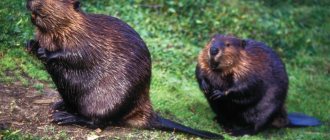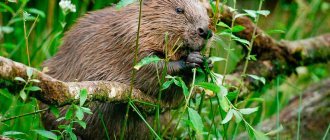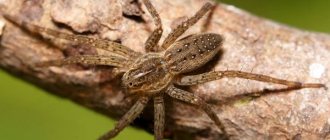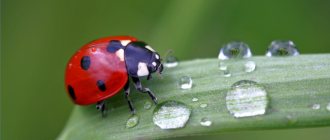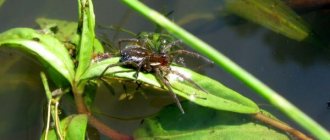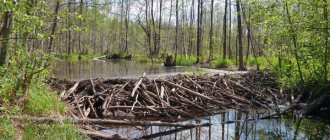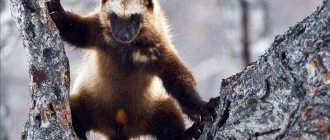20 December81292rodentsbeaver squad
The common beaver is a large semi-aquatic animal, a representative of the order Rodents. The common beaver is also called the river beaver. The beast amazes with his skills: he is an experienced builder, an excellent owner and an exemplary family man. The common beaver is the second largest rodent in the world. In this article you will find a description and photo of the common beaver and learn a lot of new and interesting things about these rodents.
Why do beavers build dams? Reasons for construction and features of structures
So, why do beavers build dams using branches, sticks, as well as stones, silt and clay? Firstly, these hardworking animals are faced with the task of changing the direction of water flow in order to subsequently flood certain places and form a kind of pond, where the beaver will later build his house, which is also called a “hut”. Secondly, by constructing a kind of artificial ponds with the help of dams, beavers create the most favorable conditions for the appearance of thickets and marsh vegetation in the creeks. Thus, plantations of lush greenery become an additional help in the diet of animals. Interesting: How pigeons began to bring mail
Tail alarm and magic jet
Not only the teeth, but also the tail help the beaver survive. Flat, like a shoulder blade, it acts as a rudder while swimming. It also allows you to warn about danger - the beaver hits the water with its tail, signaling a threat to other animals. Moreover, each beaver has a special pattern on its tail, like a fingerprint.
Beavers mark their territory with the secretion of their anal glands. It is called beaver stream - since ancient times, people have used it for medicinal purposes and in perfumery. But official medicine recognized its benefits only in the form of an adaptogen - a substance that increases the body's resistance to infections.
People hunted these semi-aquatic rodents for beaver streams, fur, and meat, and beaver populations even declined in some regions. Now, according to the scientist, beaver fur has ceased to be valued, and they have learned to obtain beaver stream without killing the animal, which has allowed rodents to significantly increase their numbers.
Sometimes this leads to the fact that animals begin to harm people: they chew off power poles, and because of dams on dams, large areas are flooded, and the spawning routes of some fish are blocked.
Source
Varieties
The beaver family has only two species: the common beaver, or river beaver, and the Canadian beaver. Let's take a closer look at the types of beavers.
River
This is a semi-aquatic animal, the largest rodent in size, inhabiting the Old World, the forest-steppe zone of Russia, Mongolia, and China. They settle along the banks of slow-flowing rivers, irrigation canals, lakes and other bodies of water, the banks of which are covered with trees and bushes.
Canadian
In appearance it differs from the river beaver in having a less elongated body, a short head and larger ears. The color is blackish or reddish brown. It lives throughout almost the entire United States (except for Florida and most of Nevada and California), in Canada, except for the northern regions.
Nutrition
The main criterion for choosing a place for animals to live in nature is the sufficient availability of food. The diet of beavers is quite varied.
Read also: Why do they remove fallen leaves?
They eat the bark of trees growing near bodies of water and aquatic plants. They love to eat the bark of aspen, linden, and willow. Reeds, sedges, nettles, sorrel and other plants are what beavers eat.
Scientists who observed their life and what beavers eat in nature counted up to 300 different plants that serve as food for the animals.
Most beavers live in families and touchingly care about the well-being of their “relatives” - they build houses and stock up on food for the winter. They painstakingly place tree branches on the bottom of the reservoir, which they eat in winter. Such reserves for one family reach ten or more cubic meters.
If, due to the river flow, it is not possible to build their “cellar”, beavers come out onto land at night to find food. They take great risks: beavers, slow on the ground, easily fall into the clutches of four-legged predators, most often wolves.
Transportation and storage of feed for the winter
A little has already been said about preparing food for future use, and the beaver family works on this matter from young to old. But transporting the obtained food to the huts is carried out in different ways. If it is not far from the river, then the rodents clamp the thick end of the branch with their teeth and move back to the pond. If the place of wood extraction is located at a great distance, then the beavers pull the branches, dragging them to the side of themselves.
During preparation for wintering, animals harvest about 30 cubic meters of wood, but if the reservoir is rich in aquatic vegetation all year round, then reserves may not be produced. Gnawing on a tree, beavers gradually move around the thick trunk, gnawing deeper and deeper. Having taken a short break, the rodent continues to work until the tree breaks and collapses from its own weight. The animal carefully separates the fallen wood: separately logs, separately branches and bark. What is not eaten immediately on the spot remains in the bins.
Why do beavers build dams? Reasons, techniques, facts
Any child knows that every beaver is an excellent builder! These representatives of the animal world build such amazing and perfect dams from fallen trees that an experienced engineer and talented hydraulic engineer could envy such structures! Why do beavers build dams?
The vastness of our planet is home to a huge number of animals leading both semi-aquatic and aquatic lifestyles. In the CIS, one of the funniest and most attention-grabbing aquatic inhabitants is the beaver, because literally its entire life is connected with water. Most often beavers live:
- in lakes;
- in streams;
- in rivers.
A large flat tail and webbed hind paws allow the beaver to move quickly, easily and freely through the water, and with the help of long, strong incisors, this animal manages not only to gnaw incredibly thick branches, but even to fell huge trees, which at first glance is simply impossible to do! Another amazing feature of the beaver and its adaptation for living in water is the isolation of its incisors from the rest of the oral cavity. This allows the beaver to chew on branches and trees underwater, eliminating the possibility of choking.
Appearance of the animal
Beavers are fairly large rodents that are fully adapted to a semi-aquatic lifestyle. The body length of a male can reach 1.5 meters, and the height at the withers can be up to 36 centimeters. Adults weigh up to 33 kilograms.
The beaver's body is squat and barrel-shaped. The limbs are five-fingered, but shortened. The hind legs are much stronger than the front legs. Since beavers spend most of their lives in water, they have special swimming membranes between their toes.
Beavers have one of the most beautiful furs and consist of coarse guard hairs. The underfur in the fur is thick, but silky. The color of the fur is heterogeneous, since its color depends on the heredity of the beavers. Body color can vary from light chestnut to dark brown. The paws and tail are usually black.
Platinum
To maintain the water level in the beaver town, rodents build dams. The building materials are tree trunks, brushwood, and sometimes stones. The structure is held together with silt and clay. A drain is installed at one edge of the platinum.
The record for the length of the dam belongs to the Canadian beaver. In the northern US state of New Hampshire, a dam more than 1200 meters long was discovered.
The usual size of platinum is 20-30 meters in length. The width at the base is 4-6 meters, at the top - 1-2 meters. The height of the structure is usually about two meters.
What is a beaver's hut? What does it look like and why build it?
After the dam is built, the beavers begin building their future home. “Huts” are real engineering structures made of soil and tree branches of different sizes, which from the outside remind a person of an ordinary pile of brushwood. Such houses look like an inverted bowl, consisting of two spaces separated from each other. One such room is filled with small rubble, it serves as a home for a whole family of animals, while the second, near the exit, is a storage room for tree branches and shoots (the food supplies of these animals). Usually the house of the beaver family protrudes above the water surface by 1–3 meters, but the entrance to it is always under water, where even in very severe frosts the water does not freeze. Moreover, during construction, smart animals strictly control the size of the entrance and arrange the approach to the house in such a way that only beavers can enter it. At the top of the “hut” there is a small hole through which light and fresh air enter the beaver’s home. In beaver “huts” animals store food supplies, sleep, and raise beaver cubs. The cozy and warm home of beavers also helps them protect themselves from enemies and wait out the cold seasons. Interesting: The bird of prey is a hawk. Who eats it?
Beavers not only carefully plan the construction of the dam, but also closely monitor this structure. If any damage occurs, the animals immediately begin repairing their home, since the safety of the entire family depends on it.
No entries found.
River "engineers"
Beavers have gained wide popularity and universal respect as skilled four-legged “civil engineers,” as well as lumberjacks and creators of unique dams. These animals became not only a symbol of perseverance and hard work, but also passed on some experience to people. The fact is that the beaver dam is a real breakthrough in construction and a ready-made engineering solution that man borrowed from these river inhabitants!
Scientists have noticed that beavers living near large bodies of water may not build any dams at all. They just need to dig a hole in a steep bank. But this is the exception rather than the norm. Nevertheless, these animals became famous for their phenomenal ability to block entire streams with dams, as well as the valuable skill of building island huts impregnable to enemies.
How do beavers build dams?
And everything is extremely simple. Hardworking beavers are river dwellers. They live in water. First, they choose a place on the river that they like, most often it is shallow water. Then, very painstakingly, day after day, they drag out all kinds of twigs and sticks and build a kind of partition from them. This entire structure can be supported by silt and stones. The partition, in other words the dam, regulates the water level in the area of the beaver settlement. The construction process itself is quite interesting. After the first layer of the dam is laid and fastened, the second, third, and so on are laid. When construction approaches the upper part of the bank, the beavers change the direction of laying the building materials. Now they lay the branches parallel to the base of the dam and across the previously laid layers.
Search for food
Beavers are nocturnal. At dusk they leave their burrows and huts, going for food. Their diet consists of plant foods: grasses, lush semi-aquatic vegetation, leaves, and the bark of various deciduous trees. Since this food is not too high in calories to fill up, beavers feed all night, going to bed only in the morning.
In autumn, animals begin to store food for the winter, branches of trees and shrubs, storing them at the bottom of the reservoir. If there is little food left near the home, beavers go to the nearby forest for food. To transport branches, they use water-filled ditches formed on the site of deeply trodden paths, or even specially dig them.
